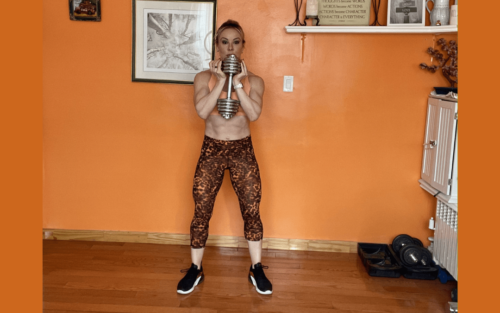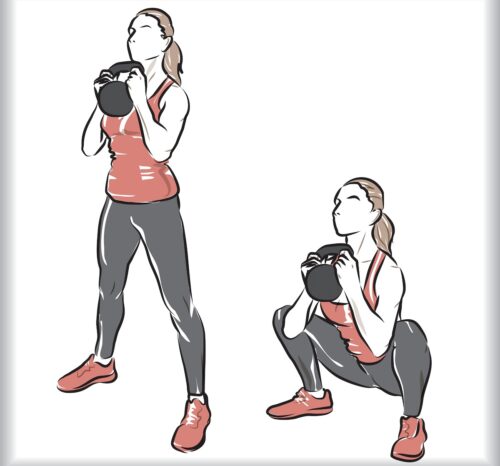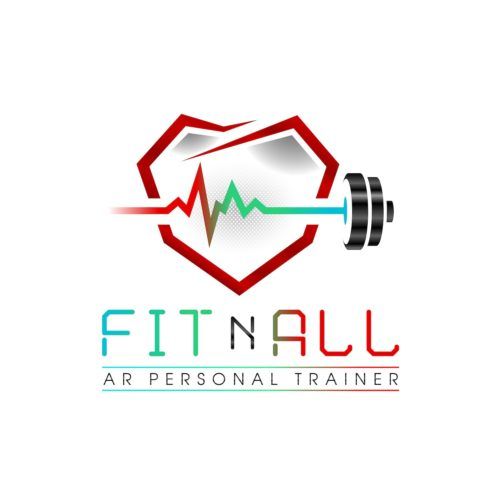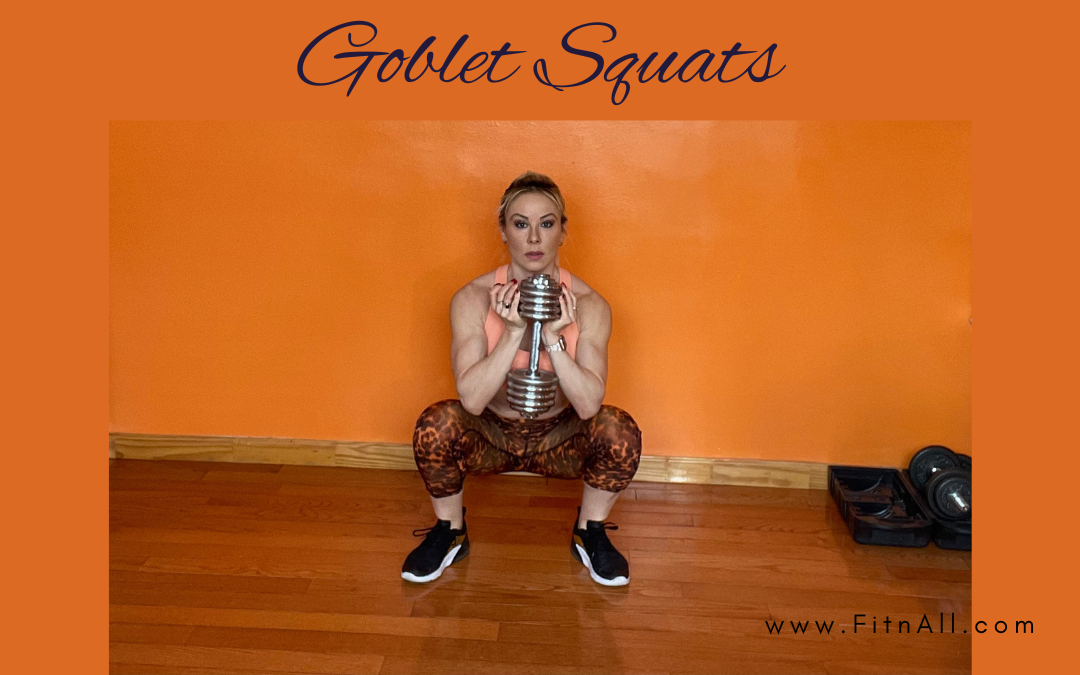Do you want to work your whole body with one exercise? There is a great exercise that works your upper and lower body. This variation of the squat is the goblet squat. Being that it is a compound movement, it works a lot of muscles and joints simultaneously.
Below we’ll look deeper into the good morning exercise and we’ll cover the following:
- Muscles involved in goblet squats
- Benefits associated with the goblet squat
- How to properly do goblet squats
- Common mistakes when performing goblet squats
- Video on how to do goblet squats
- Exercises to complete your leg workout
What Muscles Do Goblet Squats Work?
- Quadriceps or Quads: This large muscle group is located on the front of the thigh, the front & sides of the femur. It’s composed of four muscles (rectus femoris, vastus lateralis, vastus medialis, and vastus intermedius). The origin of the name, quad, means four – hence quadricep (four-headed muscle). The quadriceps are knee extensors and hip flexors – essential for in walking, running, jumping, and squatting. They, also, help to stabilize the patella and knee joints.
- Gluteal Muscles (buttocks): These muscles are involved in the extension, abduction, and rotation of the hip joint. They also help keep the body erect and assist human locomotion (running, jumping, sprinting, etc).
- Hamstrings: Located on the posterior thigh in between the hip and the knee, and are composed of three muscle groups (semitendinosus, semimembranosus, and biceps femoris – long and short heads). These muscles are antagonists to the quadriceps and are involved in hip and knee movements. They participate in the deceleration of knee extension and help flex the knee and extend the hips. They are essential for daily movement (walking), speed (running), and deceleration (stopping movement).
- Scapular Stabilizers: These muscles function synergistically to anchor the scapula, guide movement, and resist spinal flexion. The muscles involved are the upper back muscles (serratus anterior, rhomboid major and minor, levator scapulae, and trapezius) and the muscles of the rotator cuff (the supraspinatus, infraspinatus, teres minor, and subscapularis).
- Core Muscles: The erector spinae (set of muscles that run vertically along the side of the vertebral column, originating at the hip and extending up to the skull. They help rotate and extend the spine and neck) and abs (muscles in the abdominal wall: rectus abdominis, obliques, transverse abdominal) make up the core muscles.
- Biceps (biceps brachii): These muscles are on the front of the arms and have 2 heads (short and long head)
- Forearms: Located in the upper limbs between the elbows and the wrists. They help hold the weight.
- Gastrocnemius: Superficial two-headed muscles that are in the back part of the lower leg, forming the calves. They flex the foot at the ankle joint and the leg at the knee joint. They are involved in fast movements such as running and jumping.

Goblet Squats’ Benefits
After learning what muscles goblet squats work, let’s look into the benefits associated with this exercise:
- Fat Loss: Being that the goblet squat is a compound exercise that engages multiple joints and muscle groups simultaneously, it helps you to burn more calories and, subsequently, more fat.
- Aesthetics: Goblet squats help sculpt a rounded booty, shapely legs, and beautiful arms and back.
- Growth Hormone Release: They increase growth hormone. This helps to keep you young and strong. It increases vitality, strength, protein synthesis, and metabolism.
- Strength: Goblet squats help strengthen your legs, glutes, upper back, and biceps. This movement allows you to get stronger, not only while performing other types of squats but during deadlifts, rows, bicep curls, snatches, and cleans as well. You can increase your strength by using high volumes for 3, 5, or 8 reps.
- Core Strength: This movement tightens and strengthens your core (your lower back, abs, diaphragm, obliques, and pelvic floor muscles).
- Endurance & Performance: This compound exercise can also translate into improved athletic performance and less muscle fatigue. You can increase muscular endurance by using lighter loads for 12-20 reps and 2-4 sets.
- Grip & Forearm Strength: Goblet squats help to strengthen your forearms and grip as you have to hold a weight in front of you for long periods. This is useful in other exercises such as rows, pull-ups, snatches, and cleans.
- Balance: Having the weight in front in the descent and lowest positions helps you become more balanced and stable.
- Flexibility & Mobility: They involve a big movement, making you more mobile to help prevent injuries/tightness.
- Back Health & Posture: Goblet squats strengthen your scapular stabilizers and core, helping keep your back healthy. This helps to prevent injuries & back pain and to improve your posture.
- Great for Beginners: This movement is a little bit easier for beginners than the front or back squat since having the weight up high in the front forces your back to stay upright and to push your hips back. Goblet squats can help establish greater control and movement awareness.
- Efficiency: This is a highly efficient exercise that works multiple muscles simultaneously. Plus, all you need is a kettlebell or a dumbbell.
How to Do Goblet Squats

- Grasp a kettlebell or dumbbell in both hands. Bend your elbows so the weight is positioned right at the center of your chest
- Position your feet a bit wider than shoulder-width apart and pointed outwards – about 15 degrees
- Stand with your chest lifted, back straight, shoulders back, core tight, and your head facing straight ahead throughout the squat
- As you descend down, inhale and press your hips back and lower down
- Get your hips below parallel to the floor
- Keep the weight close to your body during the movement
- Maintain your weight toward your heels—you shouldn’t put your weight on the ball of your feet
- At the bottom of the squat, your elbows should touch the inside of the knees
- Exhale as you rise and press through your heels to the starting position Press your hips forward at the top of the squat to engage your glutes
- Repeat
*️⃣ You can perform a variation of the Goblet Squat by pausing at the bottom
Goblet Squats’ Mistakes
Now that you know how to do goblet squats, let’s look into the common mistakes associated with this exercise:
- Rounding your back and shoulders: This can hurt your back. Aim to keep your chest open and shoulders back to help maintain your back straight.
- Holding the weight too far away from your body: This over-emphasizes the shoulders and biceps more than intended. The weight should be close to your body by your chest. This allows your legs to lift the weight.
- Leaning forward from the waist: Leaning forward prevents you from keeping a neutral spine, throws you off balance, and puts your weight on your toes instead of your heels.
- Keeping your weight on the ball of your feet or toes. This pushes your knees and hips forward, preventing you from fully engaging the glutes. Aim to keep your feet rooted.
- Having your knees caving inward as you sink down (this is referred to as knee valgus): You avoid that by allowing your elbows to touch the inside of your knees at the bottom of the squat and engage your glutes. Your knees should be angled slightly outward instead of inward.
- Doing half-squats: You should perform the squat’s full range of motion. Stopping the movement before hitting the full bottom of the position doesn’t allow you to reap the full benefits of the exercise.
Goblet Squat Video
Leg Workout
Now that you know how to do goblet squats, what muscles goblet squats work, and the mistakes and benefits of goblet squats, you can complete your leg workout by performing the following exercises:
As you can see the goblet squat is a wonderful exercise for the posterior chain muscles. It offers tremendous benefits associated with hypertrophy, strength, endurance, and aesthetics. Now that you know how to properly perform goblet squats, you can avoid the most common mistakes and enjoy their benefits. Remember, whether you want to lose weight, tone your body, or gain strength or size, all muscles must be trained.
Lift, Burn More Fat, Get Stronger and Live Healthier!
To a Fitter Healthier You,
The Fitness Wellness Mentor



